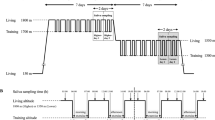Abstract
Relationships between the postexercise values of blood lactate concentration, pH, oxygen uptake, heart rate, power output on the one hand, and the pre- and postexercise blood cortisol concentrations on the other, were studied in 74 male and 40 female athletes (wrestlers and senior and junior rowers), performing graded exercise of increasing intensity. The senior rowers, junior rowers and wrestlers had different exercise protocols. The senior rowers of both sexes had significantly higher rest concentrations of serum cortisol than the junior athletes. A significant correlation between postexercise lactate concentrations and pre-exercise cortisol concentrations was found in all the male groups (“common”r = 0.515,P < 0.001), but not in the female ones (r = 0.162) . It was concluded that the pre-exercise cortisol concentrations might condition anaerobic-glycolytic metabolism in physical exercise.
Similar content being viewed by others
References
Brandenberger G, Follenius M, Muzet A (1984) Interaction between spontaneus and provoked cortisol secretory episodes in man. J Clin Endocrinol Metab 59:406–411
Booth A, Shelley G, Mazur A, Tharp G, Kitten R (1989) Testosterone, and winning and losing in human competition. Horm Behav 23:556–571
Buono MJ, Yaeger JE, Hodgen JA (1986) Plasma adrenocorticotropin and cortisol responses to brief, high-intensity exercise in humans. J Appl Physiol 61:1337–1339
Chin AK, Evonuk E (1971) Changes in plasma catecholamine and corticosterone levels after muscular exercise. J Appl Physiol 30:205–207
Dobrzański T, Żurowski S, Graban W (1979) Chronoendocrinological studies in athletes. Circadian rhythms of T3, TSH, cortisol and testoterone. Acta Physiol Pol 30:489–497
Donhoffer S, Varnal J, Szieberth-Horvath E (1958) Über die Rolle der Nebenniere in der akuten Wirkung der Trijodthyroessigsdure auf den Energieumsatz und die Körpertemperatur des hypophysectomierten Ratten. Pflügers Arch 266:642
Few JD, Frenkl R, Csalay L (1970) On the endocrine adaptation to regular muscular activity. J Sports Med Phys Fitness 10:1–7
Galbo H (1983) Hormonal and metabolic adaptation to exercise. Thieme, Stuttgart
Gallagher CH (1960) The mechanism of action of hydrocortisone on mitochondrial metabolism. Biochem J 74:38–43
Häkkinen K, Keskinen KL, Alen M, Komi PV, Kauhanen H (1989) Serum hormone concentrations during prolonged training in elite endurance-trained and strength-trained athletes. Eur J Appl Physiol 59:233–238
Hartley LH, Mason JW, Hogan RP, Jones LG, Kotchen TA, Morgey EH, Wherry FE, Pennington LL, Ricketts PL (1972) Multiple hormonal response to graded exercise in relation to physical training. J Appl Physiol 33:602–606
Klusiewicz A, Zdanowicz R, Borkowski L, Ladyga M (1992) Sportspecific performance capacity of male and female junior rowers. Biol Sport 9:159–168
Kuoppasalmi K, Näveri H, Härkönen M, Adlercreutz H (1980) Plasma cortisol, androstenedione, testosterone and luteinizing hormone in running exercises of different intensities. Scand J Clin Lab Invest 40:403–409
Kuoppasalmi K, Näveri H, Kosunen K, Härkönen M, Adlercreutz H (1981) Plasma steroid levels in muscular exercise. In: Poortmans J, Niset G (eds) Biochemistry of exercise, IVB. University Park Press, Baltimore, pp 149–160
Mason JW, Hartley LH, Kotchen TA, Mougey EH, Ricketts PT, Jones LG (1973) Plasma cortisol and norepinephrine responses in anticipation of muscular exercise. Psychosom Med 35: 406–414
Mason MB, Horwarth SM, Wilnerson JE (1975) Acute blood biochemical alterations in response to marathon running. Eur J Appl Physiol 34:173–181
Métivier G (1975) The effects of long-lasting physical exercise and training on hormonal regulation. In: Howald H, Poortmans JS (eds) Metabolic adaptation to prolonged physical exercise. Birkhäuser, Basle
Näveri H (1985) Blood hormone and metabolite levels during graded cycle ergometer exercise. Scand J Clin Lab Invest 45:599–603
Port K (1991) Serum and saliva cortisol responses and blood lactate accumulation during incremental exercise testing. Int J Sports Med 12:490–494
Snegovskaya V, Viru A (1993a) Elevation of cortisol and growth hormone levels in the course of further improvement of performance capacity in trained rowers. Int J Sports Med 14:202–206
Snegovskaya V, Viru A (1993b) Steroid and pituitary hormone responses to rowing exercises: relative significance of exercise intensity and duration and performance level. Eur J Appl Physiol 65:59–65
Stupnicki R (1985) Glucocorticoids. In: Kokot F, Stupnicki R (eds) Radioimmuno- and protein binding assays in the clinical laboratory (in Polish) PZWL (Polish Medical Publishers), Warsaw, 235–244
Stupnicki R, Obmiński Z (1992) Glucocorticoid response to exercise as measured by serum and salivary cortisol. Eur J Appl Physiol 65:546–549
Stupnicki R, Obuchowicz-Fidelus B, Jedlikowski P, Klusiewicz A (1992) Serum cortisol, growth hormone, and physiological responses to laboratory exercise in male and female rowers. Biol Sport 9:17–23
Sutton JR (1978) Hormonal and metabolic responses to exercise in subjects of high and low work capacities. Med Sci Sports 10:1–6
Urhausen A, Kullner T, Kindermann W (1987) A 7-week followup study of the behaviour of testosterone and cortisol during the competiton period in rowers. Eur J Appl Physiol 56: 528–533
Vervoorn C, Quist A, Vermulst L, Erich W, de Vries W, Thijssen J (1991) The behaviour of the plasma free testosterone/cortisol ratio during a session of elite rowing training. Int J Sports Med 12:257–263
Vervoorn C, Vermulst LIM, Boelens-Quist AM, Koppeschaar HPF, Erich WBM, Thijssen JHH, de Vries WR (1992) Seasonal changes in performance and free testosterone: cortisol ratio of elite female rowers. Eur J Appl Physiol 64:14–21
Viru A (1985) Hormones in muscular activity. vol. 1 Hormonal ensemble in exercise. CRC Press, Boca Raton, Fla
Viru A (1992) Plasma hormones and physical exercise. Int J Sports Med 13:201–209
Viru A, Smirnova T (1982) Independence of physical working capacity from increased glucocorticoid level during short-term exercise. Int J Sports Med 3:80–83
Viru A, Seene T (1985) Peculiarities of adjustments in the adrenal cortex to various training regimes. Biol Sport 2:91–99
Viru A, Karelson K, Smirnova T (1992) Stability and variability in hormonal responses to prolonged exercise. Int J Sports Med 13:230–235
Author information
Authors and Affiliations
Rights and permissions
About this article
Cite this article
Stupnicki, R., Obmiński, Z., Klusiewicz, A. et al. Pre-exercise serum cortisol concentration and responses to laboratory exercise. Europ. J. Appl. Physiol. 71, 439–443 (1995). https://doi.org/10.1007/BF00635878
Accepted:
Issue Date:
DOI: https://doi.org/10.1007/BF00635878




